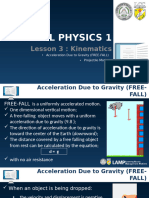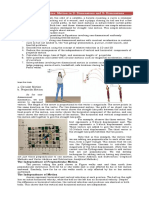0 ratings0% found this document useful (0 votes)
166 viewsVectors Addition Problem Set
This document provides instructions for a group activity on adding vectors graphically and analytically. Students will use an online simulation to add 2D vectors using the head-to-tail method and calculate the resultant vector's magnitude and direction analytically. Formulas for vector components, magnitude, and direction are provided. Students will then practice adding 2 or 3 vectors and calculating percentage error between analytical and graphical results.
Uploaded by
ZhaineCopyright
© © All Rights Reserved
Available Formats
Download as PDF, TXT or read online on Scribd
0 ratings0% found this document useful (0 votes)
166 viewsVectors Addition Problem Set
This document provides instructions for a group activity on adding vectors graphically and analytically. Students will use an online simulation to add 2D vectors using the head-to-tail method and calculate the resultant vector's magnitude and direction analytically. Formulas for vector components, magnitude, and direction are provided. Students will then practice adding 2 or 3 vectors and calculating percentage error between analytical and graphical results.
Uploaded by
ZhaineCopyright
© © All Rights Reserved
Available Formats
Download as PDF, TXT or read online on Scribd
You are on page 1/ 5
Group Activity
Vectors Addition
Group Members Name:
What are we going to learn?
We are going to learn how to add two and three vector
displacements both graphically and analytically.
Formulas needed:
𝐴𝑥 = 𝐴𝑐𝑜𝑠(𝜃)
𝐴𝑦= 𝐴𝑠𝑖𝑛(𝜃)
𝑅𝑥 = 𝐴𝑥+ 𝐵𝑥 + 𝐶𝑥
𝑅𝑦 = 𝐴𝑦 + 𝐵𝑦 + 𝐶𝑦
|𝑅| = √(𝑅𝑥 )2 + (𝑅𝑦 )2
𝑅𝑦
𝜃 = 𝑡𝑎𝑛−1 ( )
𝑅𝑥
% Error = |experimental value - accepted value|
accepted value x 100
Procedure:
Open the link below and choose “Explore 2D”
https://phet.colorado.edu/sims/html/vector-
addition/latest/vector-addition_en.html
Use the simulation to compare the resultant vector to your
answer by using the graphical/head to tail method.
Theory:
Physical quantities can be classified into two main categories:
• Scalar – is a quantity that has only a magnitude.
Example – distance, speed
• Vector – is a quantity that has both magnitude and direction. It is represented graphically as a
directed line segment. The length of the line represents the vector’s magnitude and the line’s
angle with respect to some coordinate system specifies the vector’s direction.
Example – displacement,velocity
Graphical Method:
When solving for the resultant force R ⃗ =A⃗ +B ⃗ graphically you need to use a ruler and a
protractor. By using the method of head to tail, you draw vector A and at the tip of the vector you
draw vector B with its tail on the tip of vector A. The resultant vector R would be from the tail of
A to the tip of B.
Analytical Method:
To solve for the resultant vector analytically, these steps should be followed:
1. Resolve the vectors into their components F1x, F1y, F2x, F2y ….
2. Find the x component resultant Rx = F1x + F2x + ….
3. Find the y component resultant Ry = F1y + F2y + ….
4. Find the magnitude of the resultant |RR| = √((Rx)^2+(Ry)^2 )
5. Find the direction of the resultant force θ=tan^(-1)(Ry/Rx)
The resultant vector of adding two forces:
The magnitude and direction of 𝑎⃗ and 𝑏⃗⃗ in the table
below are given, calculate the components of x and y and
the resultant force using the analytical method.
Table (1)
Force(N) Magnitude(N) Direction x-component y-component
(degree)
𝑎⃗ 7.3 𝟕𝟒. 𝟏°
𝑏⃗⃗ 5.8 𝟑𝟏. 𝟎°
⃗⃗
𝒔
Calculate the percentage error:
____________________________
Paste your graph here
Group Activity
Vectors Addition
The resultant vector of adding three forces:
Find the magnitude and direction of the resultant vector
using the analytical method. Forces(vectors) are given
in the table.
Table (2)
Force Magnitude Direction x-component y-component
(N) (N) (degree)
→ 11.2 10.3°
𝒂
→ 6.7 63.4°
𝒃
→ 13.0 180.0°
𝒄
→
𝒔
Calculate the percentage error:
___________________________
Paste your graph here
Group Activity
Vectors Addition
Questions:
Specify whether the following are vector of scalar?
Quantity Category (Vector or Scalar)
a. 5m
b. 5mi., North
c. 256 bytes
d. 30m/sec, East
e. 20 degree Celsius
What are the differences and similarities between the
resultant and the equilibrant force?
Write a conclusion of what you have learned:
You might also like
- Student Exploration: Magnetism: Vocabulary: Attract, Bar Magnet, Ferromagnetic, Magnetize, North Pole, Repel, South PoleNo ratings yetStudent Exploration: Magnetism: Vocabulary: Attract, Bar Magnet, Ferromagnetic, Magnetize, North Pole, Repel, South Pole4 pages
- General Physics I Weekly Activity Sheet 12No ratings yetGeneral Physics I Weekly Activity Sheet 124 pages
- General Physics 1: Activity Title: Physical Quantities & Errors Activity No.: 1.1 Learning CompetencyNo ratings yetGeneral Physics 1: Activity Title: Physical Quantities & Errors Activity No.: 1.1 Learning Competency4 pages
- 2021 - T1 - ppt#2 - Motion Descriptors FINALNo ratings yet2021 - T1 - ppt#2 - Motion Descriptors FINAL20 pages
- Chapter 7.1 and 7.2 - Static Charge and Electric Force. Balloons & Static ElectricityNo ratings yetChapter 7.1 and 7.2 - Static Charge and Electric Force. Balloons & Static Electricity4 pages
- Teacher Leah Rose E. Jimenez Learning Area Teaching Dates Grade Level Time SectionNo ratings yetTeacher Leah Rose E. Jimenez Learning Area Teaching Dates Grade Level Time Section2 pages
- General Physics 1: Activity Title: Center of Mass Activity No.: 2.1 Learning CompetencyNo ratings yetGeneral Physics 1: Activity Title: Center of Mass Activity No.: 2.1 Learning Competency3 pages
- Electric Charge, Coulomb'S Law, Electric Fields, and Electric FluxNo ratings yetElectric Charge, Coulomb'S Law, Electric Fields, and Electric Flux7 pages
- Addition of Vectors Final Edit Very Very FinalNo ratings yetAddition of Vectors Final Edit Very Very Final9 pages
- I. Engage: "Phet John Travoltage" Into Your Browser0% (1)I. Engage: "Phet John Travoltage" Into Your Browser4 pages
- Week 4 - General Physics Damped Oscillations PDF100% (1)Week 4 - General Physics Damped Oscillations PDF77 pages
- General Physics 1.2a Rotational KinematicsNo ratings yetGeneral Physics 1.2a Rotational Kinematics53 pages
- Kinematics Acceleration Due To Free FallNo ratings yetKinematics Acceleration Due To Free Fall23 pages
- Outline in General Physics I: Q2 Lesson 1: Rotational MotionNo ratings yetOutline in General Physics I: Q2 Lesson 1: Rotational Motion12 pages
- LAB 1 - Projectile Launched at An Angle PETA 2No ratings yetLAB 1 - Projectile Launched at An Angle PETA 24 pages
- Performance of Philippine High Schools With Special ScienceNo ratings yetPerformance of Philippine High Schools With Special Science18 pages
- 3.1 NEWTON'S UNIVERSAL LAW OF GRAVITATION PART-2 (Student's Copy)No ratings yet3.1 NEWTON'S UNIVERSAL LAW OF GRAVITATION PART-2 (Student's Copy)16 pages
- Gen. Physics Unit 1 Lesson 5 Motion in 2 and 3 DimensionsNo ratings yetGen. Physics Unit 1 Lesson 5 Motion in 2 and 3 Dimensions9 pages
- Electric Potential and Electric Potential EnergyNo ratings yetElectric Potential and Electric Potential Energy28 pages
- Physics Laboratory Worksheet in Vector AdditionNo ratings yetPhysics Laboratory Worksheet in Vector Addition8 pages
- PERIODIC MOTION & WAVES Problem Set With AnswersNo ratings yetPERIODIC MOTION & WAVES Problem Set With Answers3 pages
- Exercise 4.4 (Solutions) : K Ax by C Kax by CNo ratings yetExercise 4.4 (Solutions) : K Ax by C Kax by C16 pages
- Human Attribute Recognition by Rich Appearance DictionaryNo ratings yetHuman Attribute Recognition by Rich Appearance Dictionary8 pages
- Maximum Material Boundary (MMB) and Its Advantages in GD&T Analysis PDFNo ratings yetMaximum Material Boundary (MMB) and Its Advantages in GD&T Analysis PDF6 pages
- Tank Level Calculator Storage Tank: Head Related Size Diagram100% (1)Tank Level Calculator Storage Tank: Head Related Size Diagram29 pages
- Cbse Class X Mathematics Board Paper - 2017 All India Set - 3 Time: 3 Hours Total Marks: 90No ratings yetCbse Class X Mathematics Board Paper - 2017 All India Set - 3 Time: 3 Hours Total Marks: 905 pages
- Physics 11th Sample Question On System of PariclesNo ratings yetPhysics 11th Sample Question On System of Paricles2 pages
- Yang-Mills Interactions and Gravity in Terms of Clifford AlgebraNo ratings yetYang-Mills Interactions and Gravity in Terms of Clifford Algebra20 pages
- 2.7. Fermion Fields - The Dirac EquationNo ratings yet2.7. Fermion Fields - The Dirac Equation6 pages
- Mathematics Second Quarter Review Material: TI NO CONo ratings yetMathematics Second Quarter Review Material: TI NO CO10 pages
- 04 - Crystallogaphy III Miller Indices-Faces-Forms-EditedNo ratings yet04 - Crystallogaphy III Miller Indices-Faces-Forms-Edited63 pages
- Dimension: Not To Be Confused With - For Other Uses, SeeNo ratings yetDimension: Not To Be Confused With - For Other Uses, See7 pages
- Student Exploration: Magnetism: Vocabulary: Attract, Bar Magnet, Ferromagnetic, Magnetize, North Pole, Repel, South PoleStudent Exploration: Magnetism: Vocabulary: Attract, Bar Magnet, Ferromagnetic, Magnetize, North Pole, Repel, South Pole
- General Physics 1: Activity Title: Physical Quantities & Errors Activity No.: 1.1 Learning CompetencyGeneral Physics 1: Activity Title: Physical Quantities & Errors Activity No.: 1.1 Learning Competency
- Chapter 7.1 and 7.2 - Static Charge and Electric Force. Balloons & Static ElectricityChapter 7.1 and 7.2 - Static Charge and Electric Force. Balloons & Static Electricity
- Teacher Leah Rose E. Jimenez Learning Area Teaching Dates Grade Level Time SectionTeacher Leah Rose E. Jimenez Learning Area Teaching Dates Grade Level Time Section
- General Physics 1: Activity Title: Center of Mass Activity No.: 2.1 Learning CompetencyGeneral Physics 1: Activity Title: Center of Mass Activity No.: 2.1 Learning Competency
- Electric Charge, Coulomb'S Law, Electric Fields, and Electric FluxElectric Charge, Coulomb'S Law, Electric Fields, and Electric Flux
- I. Engage: "Phet John Travoltage" Into Your BrowserI. Engage: "Phet John Travoltage" Into Your Browser
- Outline in General Physics I: Q2 Lesson 1: Rotational MotionOutline in General Physics I: Q2 Lesson 1: Rotational Motion
- Performance of Philippine High Schools With Special SciencePerformance of Philippine High Schools With Special Science
- 3.1 NEWTON'S UNIVERSAL LAW OF GRAVITATION PART-2 (Student's Copy)3.1 NEWTON'S UNIVERSAL LAW OF GRAVITATION PART-2 (Student's Copy)
- Gen. Physics Unit 1 Lesson 5 Motion in 2 and 3 DimensionsGen. Physics Unit 1 Lesson 5 Motion in 2 and 3 Dimensions
- Human Attribute Recognition by Rich Appearance DictionaryHuman Attribute Recognition by Rich Appearance Dictionary
- Maximum Material Boundary (MMB) and Its Advantages in GD&T Analysis PDFMaximum Material Boundary (MMB) and Its Advantages in GD&T Analysis PDF
- Tank Level Calculator Storage Tank: Head Related Size DiagramTank Level Calculator Storage Tank: Head Related Size Diagram
- Cbse Class X Mathematics Board Paper - 2017 All India Set - 3 Time: 3 Hours Total Marks: 90Cbse Class X Mathematics Board Paper - 2017 All India Set - 3 Time: 3 Hours Total Marks: 90
- Physics 11th Sample Question On System of PariclesPhysics 11th Sample Question On System of Paricles
- Yang-Mills Interactions and Gravity in Terms of Clifford AlgebraYang-Mills Interactions and Gravity in Terms of Clifford Algebra
- Mathematics Second Quarter Review Material: TI NO COMathematics Second Quarter Review Material: TI NO CO
- 04 - Crystallogaphy III Miller Indices-Faces-Forms-Edited04 - Crystallogaphy III Miller Indices-Faces-Forms-Edited
- Dimension: Not To Be Confused With - For Other Uses, SeeDimension: Not To Be Confused With - For Other Uses, See





























































































